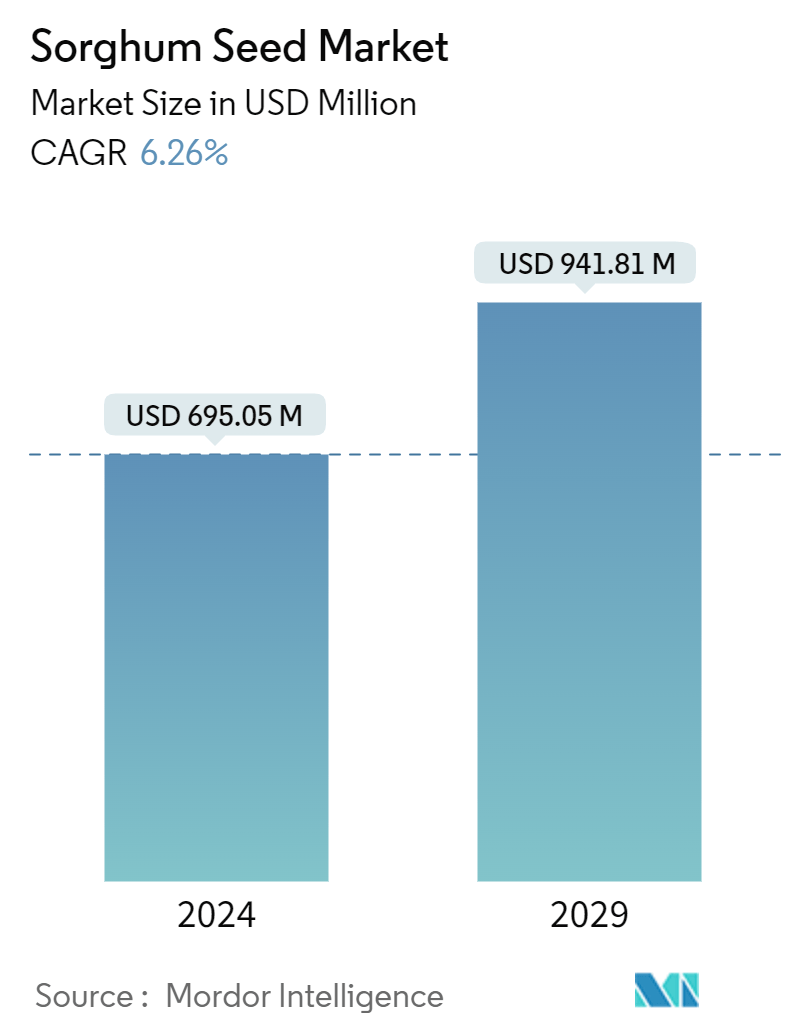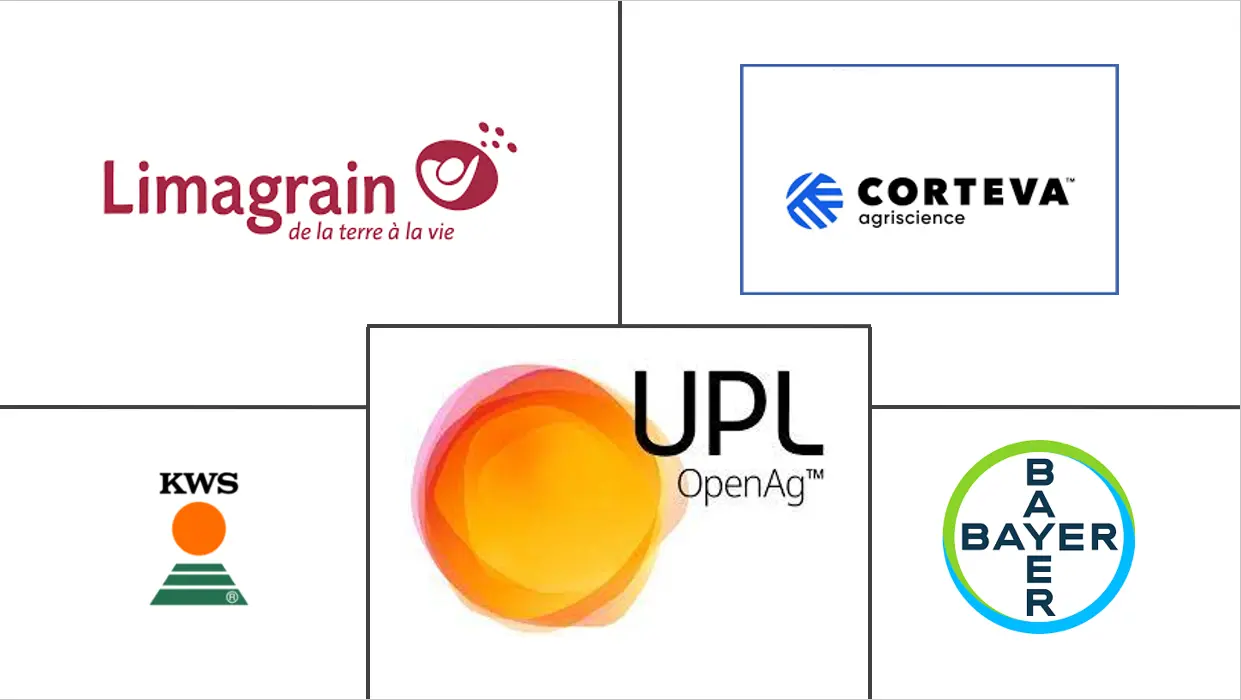Market Size of Sorghum Seed Industry

| Study Period | 2019 - 2029 |
| Market Size (2024) | USD 695.05 Million |
| Market Size (2029) | USD 941.81 Million |
| CAGR (2024 - 2029) | 6.26 % |
| Fastest Growing Market | Asia Pacific |
| Largest Market | North America |
| Market Concentration | Medium |
Major Players
*Disclaimer: Major Players sorted in no particular order |
Sorghum Seed Market Analysis
The Sorghum Seed Market size is estimated at USD 695.05 million in 2024, and is expected to reach USD 941.81 million by 2029, growing at a CAGR of 6.26% during the forecast period (2024-2029).
- Sorghum crops can be used in a wide range of fields such as human food, animal feed, and biofuels. As it requires less water for its growth, this also drives the growth in regions where there is a scarcity of water.
- Development of the hybrid sorghum varieties with excellent traits is also expected to drive the future demands for the sorghum seed market. Sorghum crops are mostly grown in arid regions like Africa, Central America, and South Asia.
- North America is the largest geographical segment of the market studied. North America is the largest producer of Sorghum, followed by Nigeria and Sudan. Even though Africa is one of the largest producers of sorghum, the need for high-quality hybrid seeds opens up larger opportunities toward the international trade markets, for sorghum seeds in the region.
- The COVID-19 pandemic affected the production, certification, distribution and cost of seeds, which play a fundamental role in developing resilient agricultural sectors. Availability and cost of transport due to the reduced number of commercial flights; fewer personnel available for production, transportation and documentation processes; and a contraction in the market for plants and seeds had also created problems in terms of the production of seed for international trade. However, the market is anticipated to grow in the forecast period majorly due to the growing demand from the animal feed sector.
Sorghum Seed Industry Segmentation
Grain sorghum is one of the major food sources for people living in developing countries in Africa and also for the people in dry areas. For the purpose of this report, the seeds of sorghum used as forage and grain have been considered. Market size estimations for the forecast years were in real terms. The average selling price (ASP) was kept constant throughout the forecast period for each country. The global sorghum seeds market is segmented by type into open pollinated varieties and hybrids. and by geography into North America, Europe, Asia-Pacific, South America, and the Middle East and Africa.
| Type | |
| Open-Pollinated Varieties | |
| Hybrids |
| Geography | ||||||||||
| ||||||||||
| ||||||||||
| ||||||||||
| ||||||||||
|
Sorghum Seed Market Size Summary
The sorghum seed market is poised for significant growth, driven by its versatile applications in human food, animal feed, and biofuels, particularly in water-scarce regions. The development of hybrid sorghum varieties with superior traits is expected to further boost demand. Sorghum is predominantly cultivated in arid regions such as Africa, Central America, and South Asia, with North America being the largest producer. Despite Africa's substantial production, the demand for high-quality hybrid seeds presents opportunities for international trade. The COVID-19 pandemic posed challenges to seed production and distribution, but the market is anticipated to recover and expand, largely due to increasing demand from the animal feed sector.
The sorghum seed market is moderately concentrated, with key players like Corteva Agriscience, KWS, Bayer, and UPL Limited actively engaging in strategies such as mergers, acquisitions, and product innovations. The market benefits from government initiatives promoting sorghum cultivation, particularly in North America, where it is a major exporter. The rising demand for animal protein and the increasing prices of corn are encouraging the adoption of sorghum as a forage crop, further driving seed demand. The introduction of new sorghum varieties, such as Corteva's Inzent trait, highlights ongoing innovation in the sector, catering to the needs of animal feed manufacturers and other industries reliant on sorghum.
Sorghum Seed Market Size - Table of Contents
-
1. MARKET DYNAMICS
-
1.1 Market Overview
-
1.2 Market Drivers
-
1.3 Market Restraints
-
1.4 Porter's Five Forces Analysis
-
1.4.1 Bargaining Power of Suppliers
-
1.4.2 Bargaining Power of Buyers
-
1.4.3 Threat of New Entrants
-
1.4.4 Threat of Substitutes
-
1.4.5 Degree of Competition
-
-
-
2. MARKET SEGMENTATION
-
2.1 Type
-
2.1.1 Open-Pollinated Varieties
-
2.1.2 Hybrids
-
-
2.2 Geography
-
2.2.1 North America
-
2.2.1.1 United States
-
2.2.1.2 Canada
-
2.2.1.3 Mexico
-
2.2.1.4 Rest of North America
-
-
2.2.2 Europe
-
2.2.2.1 United Kingdom
-
2.2.2.2 Germany
-
2.2.2.3 Spain
-
2.2.2.4 Russia
-
2.2.2.5 Ukraine
-
2.2.2.6 France
-
2.2.2.7 Italy
-
2.2.2.8 Rest of Europe
-
-
2.2.3 Asia Pacific
-
2.2.3.1 China
-
2.2.3.2 India
-
2.2.3.3 Japan
-
2.2.3.4 Australia
-
2.2.3.5 Rest of Asia-Pacific
-
-
2.2.4 South America
-
2.2.4.1 Brazil
-
2.2.4.2 Argentina
-
2.2.4.3 Rest of South America
-
-
2.2.5 Middle East and Africa
-
2.2.5.1 Nigeria
-
2.2.5.2 South Africa
-
2.2.5.3 Rest of Middle East and Africa
-
-
-
Sorghum Seed Market Size FAQs
How big is the Sorghum Seed Market?
The Sorghum Seed Market size is expected to reach USD 695.05 million in 2024 and grow at a CAGR of 6.26% to reach USD 941.81 million by 2029.
What is the current Sorghum Seed Market size?
In 2024, the Sorghum Seed Market size is expected to reach USD 695.05 million.

